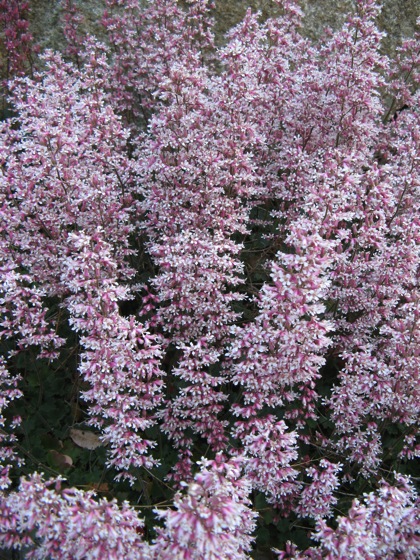Coral Bells or Alum Root (Heuchera) via BeWaterWise.com
A few months ago I was invited down the office of the Metropolitan Water District to meet a number of people involved in their BeWaterWise.com project to help reduce water usage in California. As part of their efforts, they focus on providing plant alternatives to water hungry lawns. Over the next several weeks, I will be highlighting some of their garden alternatives as part of this series. For more information on these plants and other water conservation ideas and programs, vist BeWaterWise.com — Douglas
A bunch of urn-flowered alumroots (Heuchera elegans) in Mt. Wilson (California). Photographed and uploaded by user:Geographer (Wikipedia)
Slender, spiky stems of loose, small bell-shaped owes grow from clumps of round scalloped leaves. The delicate blossoms come in shades of red, coral, rose pink, greenish and white. Most varieties bloom between early spring and late summer, with some lasting until fall. They work great in cut arrangements and are long-lasting. In warmer areas, they do best with afternoon shade and moderate to regular water. And, hummingbirds like them. — BeWaterWise.com
Heuchera /ˈhjuːkɨrə/[1] is a genus of herbaceous perennial plants in the family Saxifragaceae, all native to North America. Common names include alumroot and coral bells. They havepalmately lobed leaves on long petioles, and a thick, woody rootstock. The genus was named after Johann Heinrich von Heucher (1677–1746), an 18th-century German physician.[2]There are approximately 37 species, but the taxonomy of the genus is difficult because the species often intergrade with one another, hybridization is common, and the flowers change markedly in proportion as they develop.[2]
Alumroot species grow in varied habitats, so some species look quite different from one another, and have varying preferences regarding temperature, soil, and other natural factors. H. maxima is found on the Channel Islands of California, where it grows on rocky, windy, saline-washed ocean shores, and H. sanguinea, called coral bells because of its cerise flowers, can be found in the warm, dry canyons of Mexico and adjacent New Mexico and Arizona.
Several alumroots and their crosses are used as ornamental plants.[2] — Wikipedia
- Coral Bells or Alum Root (Heuchera) via BeWaterWise.com
- Coral Bells or Alum Root (Heuchera) via Wikipedia
- Coral Bells or Alum Root (Heuchera) via Gardening.About.com
Previously in the Interesting Plant series:
Interesting Plant is a series from A Gardener’s Notebook blog and podcast that highlights the most interesting plants I find in my Internet and real-world travels — Douglas






